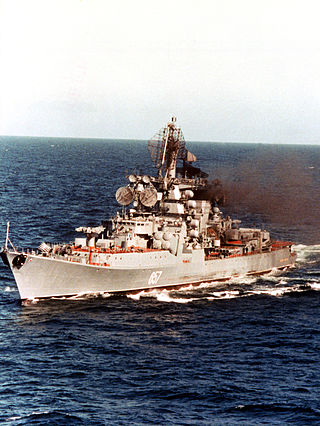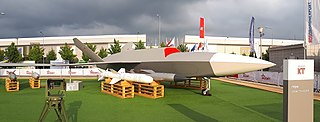Grom may refer to:
Grom may refer to:

The R-39 was a submarine-launched ballistic missile (SLBM) that served with the Soviet Navy from its introduction in 1983 until 1991, after which it served with the Russian Navy until 2004. The missile had GRAU indices of 3M65, 3M20, and 3R65. It was carried on board Typhoon-class submarines.

The Tarantul-class corvette, Soviet designation Project 1241 Molniya are a class of Russian missile corvettes.

ORP Grom was a Project 30bis destroyer, sold to the People's Republic of Poland by the Soviet Union in 1957. She was built by the Zhdanov Shipyard in Leningrad and originally served in the Soviet Baltic Fleet as the Sposobnyy. She served together in the Polish Navy with her sister ship Wicher until 1973. The ship was scrapped in 1977. Her remainings together with the Wicher were sunk in Hel as breakwaters, where they remain to this day.

An air-to-surface missile (ASM) or air-to-ground missile (AGM) is a missile designed to be launched from military aircraft at targets on land or sea. There are also unpowered guided glide bombs not considered missiles. The two most common propulsion systems for air-to-surface missiles are rocket motors, usually with shorter range, and slower, longer-range jet engines. Some Soviet-designed air-to-surface missiles are powered by ramjets, giving them both long range and high speed.

PZR Grom is a man-portable air-defense system produced in Poland and based on the Soviet man-portable infrared homing surface-to-air missile (SAM) 9K38 Igla. It consists of a 72 mm anti-aircraft missile set with a flight speed of 650 m/s, as well as a single-use launcher, re-usable gripstock and thermal battery coolant assembly electric unit. The full name of the system is Przeciwlotniczy Zestaw Rakietowy Grom.

The Kashin class, Soviet designation Project 61, were series of anti-aircraft guided-missile destroyers built for the Soviet Navy since the 1960s. As of 2020, no ships remain in service with the Russian Navy, but three modified ships continue in service with the Indian Navy as Rajput-class destroyers.

The Kresta II class, Soviet designation Project 1134A Berkut A, was a class of guided missile cruiser built by the Soviet Union for the Soviet Navy. The NATO lists the class as "cruisers" mainly due to the Metel anti-ship missile system capable to strike not only submarines but also surface vessels. They were succeeded by the larger Kara class cruisers.

The Kh-29 is a Soviet air-to-surface missile with a range of 10–30 km. It has a large warhead of 320 kg, has a choice of laser, infrared, active radar or TV guidance, and is typically carried by tactical aircraft such as the Su-24, Su-30, MiG-29K as well as the Su-25, giving these aircraft an expanded standoff capability.

The Kh-31 is a Soviet and Russian air-to-surface missile carried by aircraft such as the MiG-29, Su-35 and the Su-57. It is capable of Mach 3.5 and was the first supersonic anti-ship missile that could be launched by tactical aircraft.

The Kh-25/Kh-25M is a family of Soviet lightweight air-to-ground missiles with a modular range of guidance systems and a range of 10 km. The anti-radiation variant (Kh-25MP) is known to NATO as the AS-12 'Kegler' and has a range up to 40 km. Designed by Zvezda-Strela, the Kh-25 is derived from the laser-guided version of the Kh-23 Grom. The Kh-25 remains in widespread use despite the apparent development of a successor, the Kh-38.

The Zvezda Kh-35 is a Soviet turbojet subsonic cruise anti-ship missile. The missile can be launched from helicopters, surface ships and coastal defence batteries with the help of a rocket booster, in which case it is known as Uran or Bal. It is designed to attack vessels up to 5,000 tonnes.

Operation Storm-333 was a military raid executed by the Soviet Union in Afghanistan on 27 December 1979. Special forces and airborne troops stormed the heavily fortified Tajbeg Palace in Kabul and assassinated Afghan leader Hafizullah Amin, a Khalqist of the People's Democratic Party of Afghanistan (PDPA) who had taken power in the Saur Revolution of April 1978. It was the start of the Soviet–Afghan War.

The Zvezda Kh-66 and Kh-23 Grom are a family of early Soviet tactical air-to-surface missiles with a range of 10 km. They were intended for use against small ground or naval targets. The Kh-66 was effectively a heavy-warhead, beam-riding version of the K-8 air-to-air missile rushed into service in Vietnam in 1968. The Kh-23 was an improved Kh-66 with command-guidance, similar to the AGM-12 Bullpup.

The Polish Navy is the naval branch of the Polish Armed Forces. The Polish Navy consists of 46 ships and about 12,000 commissioned and enlisted personnel. The traditional ship prefix in the Polish Navy is ORP.

Kronstadt was a Project 1134A Kresta II-class cruiser of the Soviet Navy, named for the Kronstadt naval base. The first ship of her class, the ship served during the Cold War, from 1969 to 1991. She served with the Northern Fleet, with her shakedown cruise being through the Mediterranean Sea. After colliding with a destroyer in 1975, she spent five years being repaired and modernized. She was decommissioned in 1991 before being sold for scrap two years later due to reduced naval funding and deteriorating conditions.
The P-900 Alfa П-900 3М51 Альфа Alfa AFM-L, GRAU designation 3M51, is an anti-ship missile developed from the 3M54 Kalibr, P-800 Oniks and P-700 Granit.

Marshal Timoshenko was a Project 1134A Berkut A class cruiser of the Soviet Navy. The eighth ship of her class, the vessel served during the Cold War with the Northern Fleet, often operating in the Atlantic Ocean but also travelling to various ports in the Mediterranean and Red Seas. The cruiser was taken out of service to be modernised in 1988 but a lack of funds meant the work was not completed. Instead Marshal Timoshenko was decommissioned in 1992.

Major Grom: Plague Doctor is a 2021 Russian action film directed by Oleg Trofim, based on the comic book series of the same name by the Russian publisher Bubble Comics, created by Artyom Gabrelyanov. It is the second film adapted from Bubble Comics, as well as the first feature-length film based on a Russian comic. Prior to that, the studio had released the short film Major Grom. It stars Tikhon Zhiznevsky in the lead role, alongside Lyubov Aksyonova, Aleksei Maklakov, Aleksandr Seteykin, Sergei Goroshko, and Dmitry Chebotaryov. The film is set in Saint Petersburg and tells the story of police major Igor Grom, an honest and skilled cop with unconventional methods, who pursues a vigilante murderer in the mask of a plague doctor.

Grom is a Russian unmanned combat aerial vehicle (UCAV) being developed by Kronshtadt. It was first unveiled at ARMY-2020 forum.